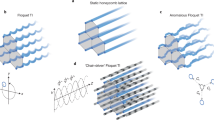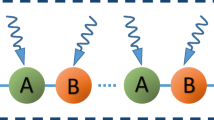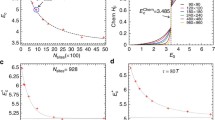Abstract
Periodically driven systems provide a new platform for studying and realizing novel topological phases of matter that cannot be observed in static systems. These so-called anomalous Floquet topological insulators support topologically protected edge states, despite having zero Chern number bands. Here, we propose a circuit realization of an anomalous Floquet topological insulator. Based on a simple model, we designed a lattice of inductors and capacitors connected through electrical switches. We cast the governing equations of the circuit in the form of a Schrodinger-like equation and implement the Hamiltonian of an anomalous Floquet topological insulator by the circuit. Using a current source for excitation, the propagation of the topological edge state in the circuit is analyzed.
Graphical abstract

A lattice of inductors and capacitors with an appropriate switching scheme produces an anomalous Floquet topological insulator







Similar content being viewed by others
Data availability statement
The datasets generated during the current study are available from the corresponding author on reasonable request.
References
D. J. Thouless, M. Kohmoto, M. P. Nightingale, and M. formula den Nijs, Quantized Hall Conductance in a Two-Dimensional Periodic Potential, Phys Rev Lett 49, 405 (1982)
F.D.M. Haldane, Model for a quantum hall effect without landau levels: condensed-matter realization of the “Parity Anomaly.” Phys Rev Lett 61, 2015 (1988)
C. L. Kane and E. J. Mele, Quantum Spin Hall Effect in Graphene, Phys Rev Lett 95, (2005)
M. Fruchart and D. Carpentier, An Introduction to Topological Insulators, Comptes Rendus Physique
L. Lu, J.D. Joannopoulos, M. Soljačić, Topological photonics. Nat Photonics 8, 821 (2014)
T. Ozawa et al., Topological photonics. Rev Mod Phys 91, 015006 (2019)
A. Blanco-Redondo, Topological Nanophotonics: Toward Robust Quantum Circuits, in Proceedings of the IEEE (2019), pp. 1–13
S. Raghu and F. D. M. Haldane, Analogs of Quantum-Hall-Effect Edge States in Photonic Crystals, Phys Rev A 78, (2008)
L. H. Wu and X. Hu, Scheme for Achieving a Topological Photonic Crystal by Using Dielectric Material, Phys Rev Lett 114, (2015)
M. Honari-Latifpour, L. Yousefi, Topological plasmonic edge states in a planar array of metallic nanoparticles. Nanophotonics 8, 799 (2019)
W. Hu, J. C. Pillay, K. Wu, M. Pasek, P. P. Shum, and Y. D. Chong, Measurement of a Topological Edge Invariant in a Microwave Network, Phys Rev X 5, (2015)
Y. Choi, C. Hahn, J. W. Yoon, and S. H. Song, Observation of an anti-PT-symmetric exceptional point and energy-difference conserving dynamics in electrical circuit resonators, Nat Commun 9, (2018)
M. Ezawa, Non-Hermitian Boundary and Interface States in Nonreciprocal Higher-Order Topological Metals and Electrical Circuits, Phys Rev B 99, (2019)
X. X. Zhang and M. Franz, Non-Hermitian Exceptional Landau Quantization in Electric Circuits, Phys Rev Lett 124, (2020)
S. Bahmani and A. N. Askarpour, Bloch Oscillations and Wannier-Stark Ladder in the Coupled LC Circuits, Physics Letters, Section A: General, Atomic and Solid State Physics 384, (2020)
J. Ningyuan, C. Owens, A. Sommer, D. Schuster, and J. Simon, Time- and Site-Resolved Dynamics in a Topological Circuit, Phys Rev X 5, (2015)
V. V. Albert, L. I. Glazman, and L. Jiang, Topological Properties of Linear Circuit Lattices, Phys Rev Lett 114, (2015)
Y. Li, Y. Sun, W. Zhu, Z. Guo, J. Jiang, T. Kariyado, H. Chen, and X. Hu, Topological LC-Circuits Based on Microstrips and Observation of Electromagnetic Modes with Orbital Angular Momentum, Nat Commun 9, (2018)
E. Zhao, Topological Circuits of Inductors and Capacitors, Ann Phys (N Y) 399, 289 (2018)
C. H. Lee, S. Imhof, C. Berger, F. Bayer, J. Brehm, L. W. Molenkamp, T. Kiessling, and R. Thomale, Topolectrical Circuits, Commun Phys 1, (2018)
K. Luo, R. Yu, H. Weng, Topological nodal states in circuit lattice. Research 2018, 1 (2018)
C.H. Lee, S. Imhof, C. Berger, F. Bayer, J. Brehm, L.W. Molenkamp, T. Kiessling, R. Thomale, Topoelectrical circuits. Commun Phys 1, 39 (2018)
S. Liu, W. Gao, Q. Zhang, S. Ma, L. Zhang, C. Liu, Y.J. Xiang, T.J. Cui, S. Zhang, Topologically protected edge state in two-dimensional su–Schrieffer–Heeger Circuit. Research 2019, 1 (2019)
S. Bahmani and A. N. Askarpour, One-Way Edge Modes Induced by Synthetic Magnetic Field in Time-Varying LC Circuit, in 2021 29th Iranian Conference on Electrical Engineering, ICEE 2021 (2021)
J. Cayssol, B. Dóra, F. Simon, and R. Moessner, Pss Floquet Topological Insulators Review @ RRL, Physica Status Solidi (RRL) - Rapid Research Letters 108, 101 (2013)
M.C. Rechtsman, J.M. Zeuner, Y. Plotnik, Y. Lumer, D. Podolsky, F. Dreisow, S. Nolte, M. Segev, A. Szameit, Photonic Floquet topological insulators. Nature 496, 196 (2013)
N.H. Lindner, G. Refael, V. Galitski, Floquet topological insulator in semiconductor quantum wells. Nat Phys 7, 490 (2011)
M. Bukov, L. D’Alessio, A. Polkovnikov, Universal high-frequency behavior of periodically driven systems: from dynamical stabilization to Floquet engineering. Adv Phys 64, 139 (2015)
T. Kitagawa, E. Berg, M. Rudner, and E. Demler, Topological Characterization of Periodically Driven Quantum Systems, Phys Rev B Condens Matter Mater Phys 82, (2010)
M. S. Rudner, N. H. Lindner, E. Berg, and M. Levin, Anomalous Edge States and the Bulk-Edge Correspondence for Periodically Driven Two-Dimensional Systems, Phys Rev X 3, (2014)
S. Qin, Q. Xu, Y.E. Wang, Nonreciprocal components with distributedly modulated capacitors. IEEE Trans Microw Theory Tech 62, 2260 (2014)
D.L. Sounas, A. Alù, Non-reciprocal photonics based on time modulation. Nat Photonics 11, 774 (2017)
S. Mukherjee, A. Spracklen, M. Valiente, E. Andersson, P. Öhberg, N. Goldman, and R. R. Thomson, Experimental Observation of Anomalous Topological Edge Modes in a Slowly Driven Photonic Lattice, Nat Commun 8, (2017)
L. J. Maczewsky, J. M. Zeuner, S. Nolte, and A. Szameit, Realization of Photonic Anomalous Floquet Topological Insulators, in 2017 Conference on Lasers and Electro-Optics, CLEO 2017 - Proceedings, Vols. 2017-Janua (2017), pp. 1–2
H.A. Haus, W. Huang, Coupled-mode theory. Proc. IEEE 79, 1505 (1991)
I. M. Georgescu, S. Ashhab, and F. Nori, Quantum Simulation, Rev Mod Phys 86, (2014)
T. Dinc, M. Tymchenko, A. Nagulu, D. Sounas, A. Alu, H. Krishnaswamy, Synchronized conductivity modulation to realize broadband lossless magnetic-free non-reciprocity. Nat Commun 8, 795 (2017)
Author information
Authors and Affiliations
Contributions
SB has performed theoretical and numerical works under supervision of ANA. All authors have contributed to the writing of the paper.
Corresponding author
Ethics declarations
Conflict of interest
The authors have no relevant financial or non-financial interests to disclose.
Appendix: energy loss in the switching process
Appendix: energy loss in the switching process
As discussed in the main text, energy stored in each element (in the form of electric field in capacitors or magnetic field in inductors) is transferred to the nearby elements through a switching process. In the ideal case, there will not be any energy loss and the scheme discussed in Sect. 2 will work perfectly. Although introducing non-ideal switches will cause energy dissipation in the circuit, the desired behavior would be still observed if certain conditions are met. These conditions which are totally achievable with the current switching technology are high speed switching in comparison to the resonant frequency of the LC resonators and high ratio between the resistance in the on and off states of the switch.
To examine the effect of a non-ideal switch on the circuit, we considered the simple case of two LC resonators with a shared inductor which are controlled by two switches, illustrated in Fig. 8. The circuit can be readily simulated by an ODE solver. Here we used MATLAB function ode45 to solve the circuit for the voltages of capacitors and the current of the inductor. The switches are modeled as time varying resistors with their time dependence given by a hyperbolic tangent function, varying between two values \({R}_{\mathrm{on}}\) and \({R}_{\mathrm{off}}\).
Here, \({t}_{s}\) is the switching time and \(w\) controls the switching speed. We define the switching period \(\Delta T\) as the time difference between the moments switch reaches 99 and 1 percent of its new resistance value.
We solved the dynamical equations of the circuit for different ratios of switching period \(\Delta t\) to the resonance period of the resonators T, \(0.01<\frac{\Delta t}{T}<0.1\). Capacitor 1 is initialized with an initial voltage of 1 Volt which is supposed to transfer to the capacitor 2 after t = \(T/2\) according to the underlying switching scheme. We set \({R}_{\mathrm{off}}/{R}_{\mathrm{on}}=100\) with \({R}_{on}=0.1{Z}_{0}=0.1\sqrt{L/C}\) and plot the voltage on each capacitor at t = \(T/2\) after the initialization.
As illustrated in Fig. 9, faster switching times helps the energy transport. The highest voltage in the capacitor 2 is obtained for the fastest switching time \(\Delta t=0.001T\), in which the voltage in the second capacitor is a little more than 0.7 V. To better show the dynamics of the circuit, we also illustrate the variations of the voltages and inductor’s current for two cases of \(\Delta T=0.01T\) and \(\Delta T=0.1T\) in Fig. 10.
The variations of the voltages of two capacitors, \({\mathrm{V}}_{1}\) and \({\mathrm{V}}_{2}\), and the middle inductor’s current \({\mathrm{Z}}_{0}\mathrm{I}\) as a function of time. \({\mathrm{R}}_{1}\) and \({\mathrm{R}}_{2}\) curves denote the on and off state of two switches. They are normalized to their maximum value here and have no dimension. Comparing two cases, the final voltage in the second capacitor \({\mathrm{V}}_{2}\) when \(\mathrm{\Delta T}=0.1\mathrm{T}\) is half of the case with \(\mathrm{\Delta T}=0.01\mathrm{T}\) which shows higher energy dissipation when the switching time is increased
Increasing the switching time increases the dissipation of inductor’s current and therefore less energy transport into the second capacitor, as illustrated in Fig. 10. Therefore to work close to the ideal case, the switching time should be as small as possible.
The current technology of MOSFET switches enables switching times of orders of a few nanoseconds with on-state resistance of a few Ohms (for instance, N-channel MOSFETs like 2N7002). CMOS switches are currently employed for the on/off resistance ratios of order of 103 – 105. [37] By choosing a high performance switch, the elements of the circuit can be chosen to provide the best possible performance.
Rights and permissions
Springer Nature or its licensor (e.g. a society or other partner) holds exclusive rights to this article under a publishing agreement with the author(s) or other rightsholder(s); author self-archiving of the accepted manuscript version of this article is solely governed by the terms of such publishing agreement and applicable law.
About this article
Cite this article
Bahmani, S., Askarpour, A.N. Anomalous Floquet topological phase in a lattice of LC resonators. Eur. Phys. J. B 96, 81 (2023). https://doi.org/10.1140/epjb/s10051-023-00553-8
Received:
Accepted:
Published:
DOI: https://doi.org/10.1140/epjb/s10051-023-00553-8







